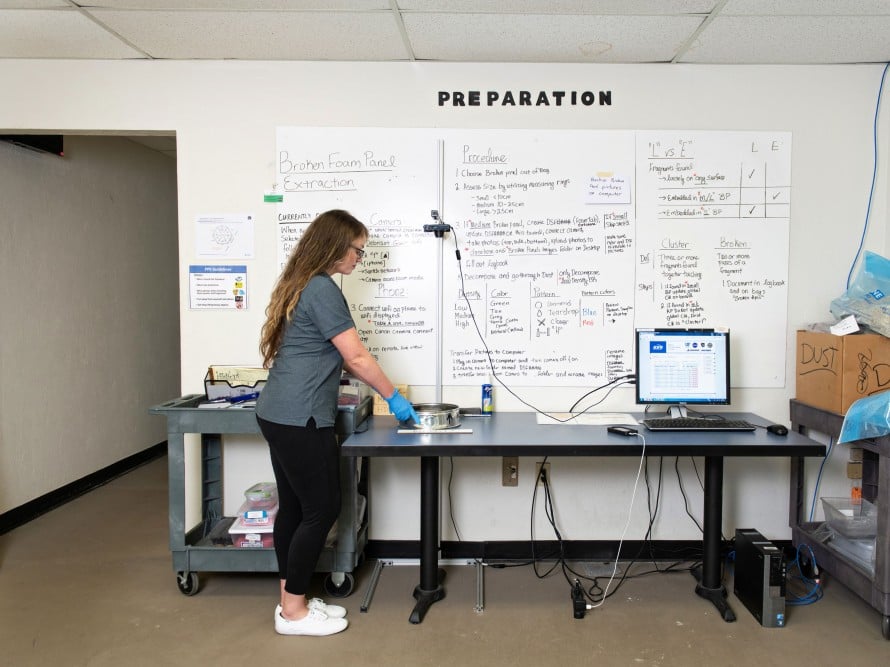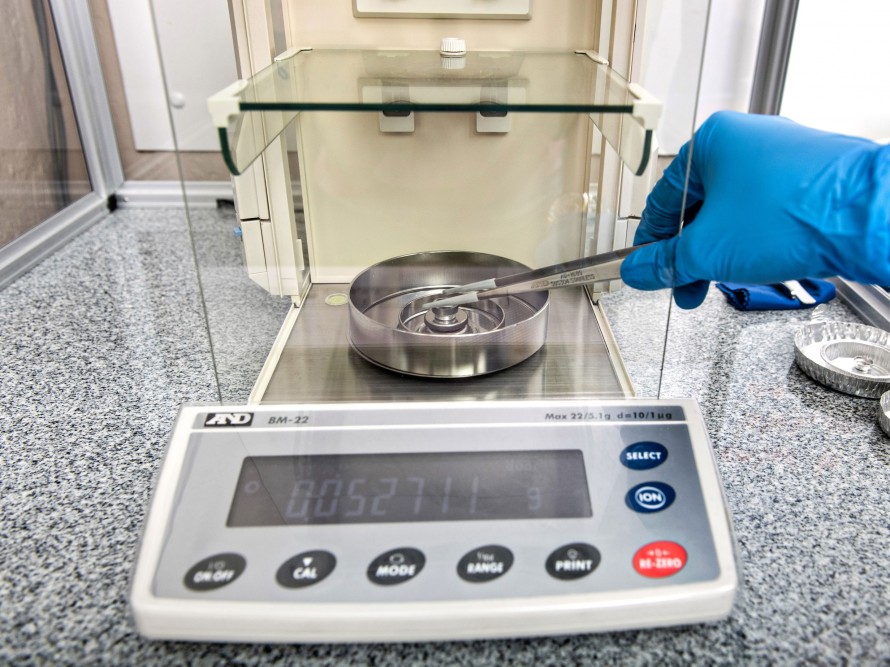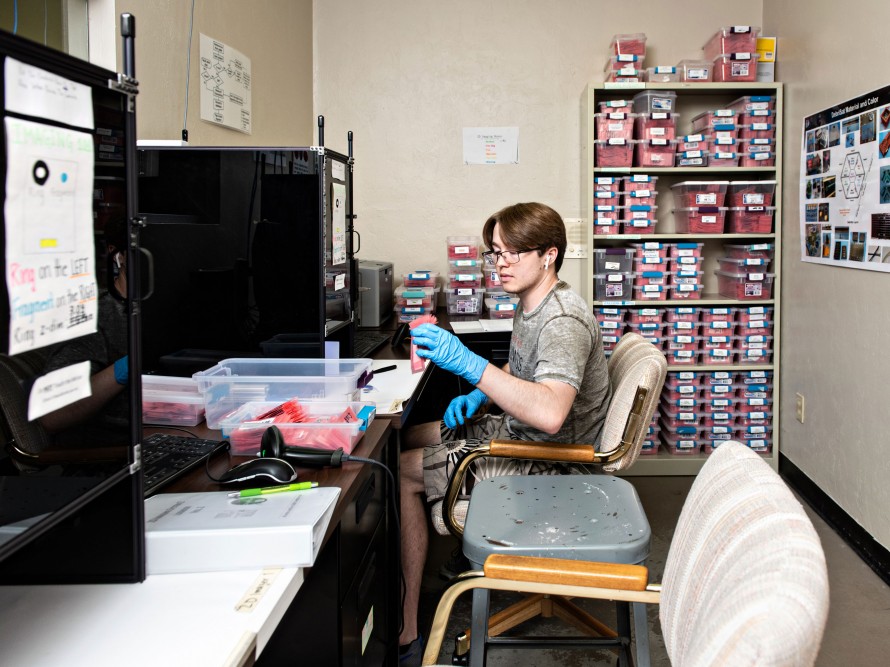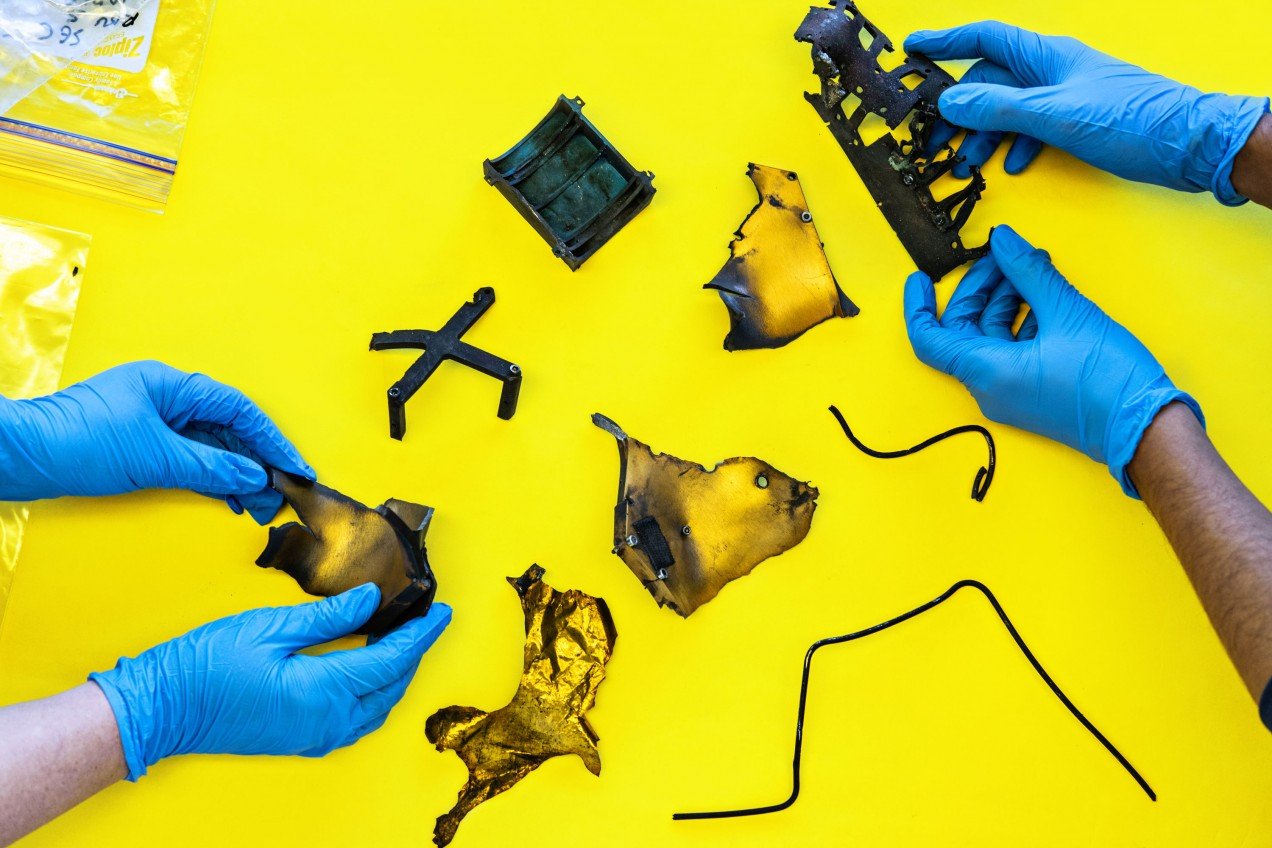

Space
How the world’s biggest gun helped solve a long-standing space mystery
A fog of micro-debris poses major risks to satellites and spaceships—and this test suggests there is a lot more of it than anyone had thought
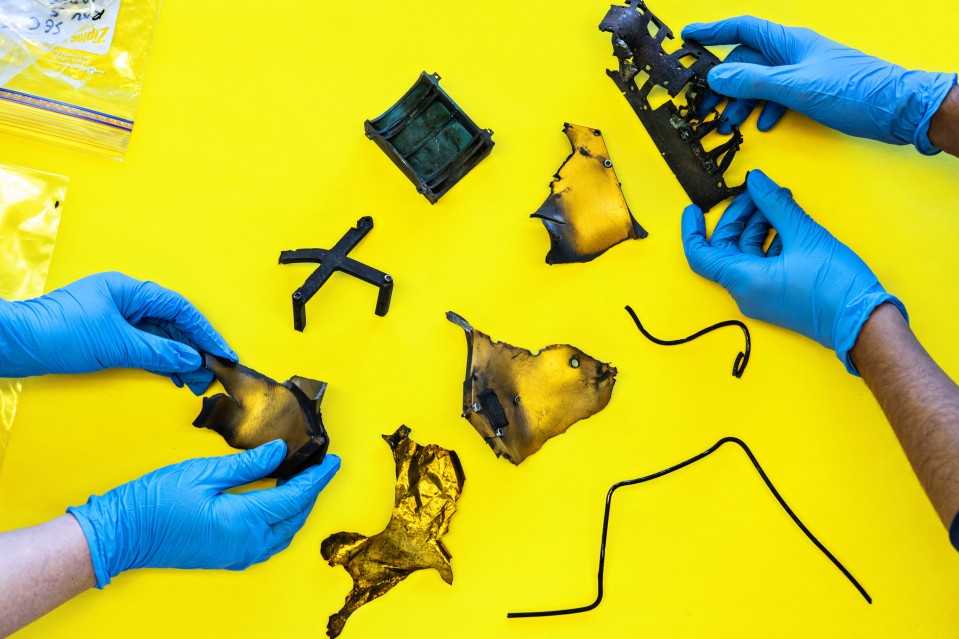
On a sweltering day in August, in a windowless strip mall office in north-central Florida, Rafael Carrasquilla and a dozen other students wore surgical gloves as they picked through piles of dust with tweezers. They were hunting for tiny slivers of carbon fiber only millimeters long, almost invisible to the naked eye. There were no ventilation fans, no sneezing or sudden movements at the lab bench.
When they found one, they logged its appearance in a database, bagged it, tagged it, and placed it among tens of thousands of others painstakingly organized in ranks of plastic bins.
For years, workers hunting for such fragments would deposit each one gently on a microbalance isolated from the rumble of passing trucks by a thick granite worktop. The average weight was about 0.5 micrograms—about a hundredth that of a human eyelash. These fragments are so insubstantial that even slight changes in temperature could skew the results, so the workers learned to wait a few minutes after entering the room before continuing with their task, to give the air-conditioned climate a chance to stabilize. “There are operators who hold their breath with the microbalance so they don’t cause a bad reading,” says Carrasquilla. Eventually, they moved on from weighing these tiniest fragments, having catalogued enough of them to understand their import. Now they meticulously count all of them but weigh only the larger ones.
Carrasquilla leads the fragment characterization effort for the University of Florida, part of a NASA-led experiment called DebriSat that began in 2011. DebriSat was created to answer a question: What happens when a piece of orbital debris slams into a satellite at thousands of miles per hour? If such a collision occurs in orbit, it’s impossible to keep track of the resulting chaos. The only way to answer that question with confidence is to cause a catastrophic impact in a laboratory down here on Earth, where conditions can be carefully controlled and results meticulously catalogued.
Orbital debris comes in many shapes and sizes, from fragments similar to those Carrasquilla’s group was analyzing to full-size rocket boosters left in space. In orbit, even miniature fragments are capable of damaging satellites or penetrating space suits. Kinetic energy increases with the square of an object’s velocity—and impacts in orbit typically happen at over 20,000 miles per hour, so that even tiny carbon-fiber needles can cause damage. “The biggest mission-ending risk to operational spacecraft comes from small, millimeter-size orbital debris, not big fat objects,” says Jer Chyi “JC” Liou, NASA’s chief scientist for orbital debris at Johnson Space Center in Texas.
But Liou’s computer models had a blind spot when it came to debris. Simulations did not match evidence brought back from orbit by the space shuttle, or what NASA was seeing in real collisions.
In January 2007, China intentionally destroyed one of its own Fengyun weather satellites using an anti-satellite missile. Then in February 2009, a defunct Russian Kosmos military satellite accidentally collided with an Iridium communications satellite high above Siberia. The two events created vast fragment clouds that forced satellites and the International Space Station to perform collision avoidance maneuvers.
“Fragments from Kosmos lined up with our predictions, but the Iridium and Chinese [breakups looked] significantly different from our models,” Liou says. “The number of fragments was a lot higher than we predicted.”
If NASA’s software was underestimating the consequences of orbital breakups and collisions, it could be putting the agency’s spacecraft—and any astronauts on board—in real danger.
NASA established the DebriSat program to get to the bottom of this discrepancy, and asked Norman Fitz-Coy, the head of the University of Florida’s Space Systems Research Group to design a mock-up satellite, also called DebriSat. On April 15, 2014, he shot it with the world’s biggest gun. Range G, as the gun is called, is buried in a tunnel under a forest at Arnold Air Force Base in Tennessee. It was built in 1963 and has been fired thousands of times in weapons tests. Its barrel was lengthened to 192 feet (58.5 meters) in 2004.
The barrel resembles an innocuous pipe: it looks less remarkable than it is. The gun has two stages. The first stage uses several hundred pounds of conventional gunpowder. After being electronically ignited, the gunpowder explodes and accelerates a piston down the inside of the pipe. The front of the piston forms a seal with the walls of the pipe: as it accelerates to nearly 2,000 mph, it compresses hydrogen gas in front of it.
Eventually, the highly compressed gas ruptures a retaining disc (by design). This releases the pent-up energy of the gas to shoot a projectile into the target at over 15,000 miles per hour. The projectile in the DebriSat test was a specially designed hollow aluminum cylinder capped with nylon, about the size of a soda can. When it hit the satellite, the collision created a quickly blooming sphere of fire that flung a cloud of tiny fragments into surrounding foam blocks, where they were softly captured. Fitz-Coy remembers feeling the distant control room he was in shake at the moment of impact.
The foam blocks were then carefully packed and sent to the strip mall in Gainesville, where Fitz-Coy’s team had set up shop. Their task was to extract from the blocks every fragment of the satellite larger than two millimeters. Fitz-Coy expected to gather and analyze around 85,000 pieces of metal, plastic, and glass and report back within a year.
Five years and 195,000 extractions later, an estimated 100,000 fragments still remain to be collected. Some fragments are small and others are large, but the sheer number suggests that every collision, explosion, and breakup in orbit is creating far more debris than anyone had previously realized.
Before DebriSat, NASA thought there were over 100 million millimeter-scale debris objects orbiting Earth, all virtually undetectable, but any one of which could wreck a satellite or puncture a space suit. The results of DebriSat, along with other NASA research, suggest that this estimate drastically undercounts the smallest fragments in space—and the outsize risk they represent.
As humanity gears up to launch thousands more satellites and dozens of new crewed missions in the years ahead, we must face the fact that the micro-debris we can’t see up there is arguably even more dangerous than the space junk we can.
In 1978, NASA scientists Donald Kessler and Burton Cour-Palais published a paper warning that a cascade of satellite collisions could create an artificial “asteroid belt” of debris around the Earth that would hamper future launches, a phenomenon that came to be called the Kessler Syndrome.
NASA estimates that there have been over 250 significant debris-causing events in orbit since 1961, mostly from the explosive breakup of spacecraft and rocket bodies. Debris from the Iridium-Kosmos collision and the Chinese anti-satellite test over a decade ago still accounts for about one third of all the objects catalogued in orbit.
But why did NASA’s models get the number of Kosmos fragments right, and the others so wrong?
One obvious difference was that the Russian Kosmos was considerably older than the other spacecraft. Liou suspected that the Iridium and Chinese Fengyun satellites produced an unexpectedly large number of fragments because they used carbon-fiber composites and multilayer thermal insulation. Fragments of these lightweight modern materials might decay into the atmosphere faster than metals (fragments of comparable size have less inertia, and thus are more susceptible to atmospheric drag), but it appeared that there were many, many more of them.
NASA’s existing model was based on a 1992 test, in which a 1960s satellite called Transit was blasted by the same giant gun in Tennessee. But Transit was old, like the Kosmos, with more metal and less plastic than today’s satellites. The 1992 version of the gun was also less powerful than the 2014 one, and the analysis of the resulting fragments was done in haphazard fashion. Although other hypervelocity tests have been conducted before and since, the Transit test was the only time a flight-ready satellite had been blown up on Earth. Today’s best orbital collision models are still largely based on its aging, incomplete data.
The risks of relying on inaccurate models became clear in 2014, when the National Oceanic and Atmospheric Administration (NOAA) was putting finishing touches on its latest weather satellite. The Joint Polar Satellite System, or JPSS-1, is one of the first satellites in a $19 billion, 40-year effort to collect reams of data on clouds, surface temperatures, atmospheric gases, and wildfires to improve the timeliness and accuracy of forecasts in advance of severe weather events. It would also track volcanic eruptions, detect forest fires, and spot the early signs of drought.
NOAA naturally wanted to ensure that JPSS-1, itself having cost around $2 billion, would survive for its entire seven-year lifetime. As is common for large, expensive satellites, its builders carried out a risk assessment using computer models from three separate agencies—NASA, the European Space Agency, and an independent research organization. All more or less agreed on the threat posed by micrometeoroids and orbital debris larger than three millimeters.
But then Liou’s team released a new version of NASA’s engineering model for orbital debris. The NOAA scientists ran the numbers again, expecting to see only minor changes, and got a nasty surprise. The latest software was far more pessimistic than the previous models, predicting that JPSS-1 might experience up to 160 times more damage from fragments a millimeter or smaller. Whereas the previous version has given the JPSS-1’s propellant tank a 1% chance of suffering a mission-ending impact, there was now an unacceptable 26% risk of catastrophe.
The risk had jumped because the new software now included data from the only NASA instrument that had actually, if involuntarily, sampled micrometeoroid and orbital debris in low Earth orbit. The space shuttle ran the gauntlet of orbital debris for nearly 30 years, gathering all kinds of chips, bumps, and small holes from hypervelocity impacts during its time aloft. From 1992 to the shuttle’s retirement in 2011, its windows and radiators were examined in detail for damage from orbital debris. The big surprise was that researchers found over 2,600 impact craters on just these surfaces, corresponding to over 10 times more millimeter-scale fragments than expected.
In situ impact data from the shuttles is still the best NASA has. (The US Air Force’s X37B uncrewed spaceplane likely collected similar data during its clandestine multiyear missions, which remain classified.) But the source of the small debris was a mystery. Something was generating vast quantities of it in low Earth orbit, and nobody knew what it was or how it was happening.
NASA’s DebriSat test, which promised to reveal some of the mysteries around breakups and collisions, suddenly seemed even more important. But first, Fitz-Coy would have to design and construct a satellite as realistic as the JPSS-1, on a tiny fraction of NOAA’s budget.
“We basically went through the same process one would take if building a real satellite,” he says. “We had all the hardware, the cabling, the electronics and optics on board—everything except the software.”
Some of the cheaper components, such as an inertial measurement unit and a reaction wheel, were donated by manufacturers. For more expensive hardware, like precision star trackers, Fitz-Coy’s team borrowed a sample and built as close a copy as they could. Nothing needed to actually work; it just had to have the right materials in the right places.
Fitz-Coy knew that with NASA’s limited budget for expensive debris tests, DebriSat might be the last breakup experiment for another 20 or 30 years. So he tried to anticipate how satellites would be built in the future. For instance, “the battery we chose was lithium-polymer rather than a typical nickel-cadmium,” he says. The satellite would also feature the multilayer insulation, deployable solar panels, and carbon-fiber structural elements found on virtually all new satellites larger than cubesats.
NASA returned to Range G for the experiment, covering almost every square centimeter of the blast chamber with layers of color-coded foam panels, increasing in density to trap ever more energetic fragments. Before-and-after photos of the experiment show that the hypersonic blast had transformed the neat test chamber at Arnold into a chaotic mess of broken foam and hanging cables. Fitz-Coy’s satellite appeared to have simply disappeared.
When the first foam panels arrived in Gainesville, some were largely intact, while others had splintered into pieces. They were x-rayed and the resulting images were computationally stitched together, run through an object detection algorithm, and projected back onto the physical panel. Students inserted pins into the foam wherever the projection indicated that fragments were lurking. The x-rays could identify where fragments were, but little else about them.
Then the tweezers came out. “It’s the exact same manual task that an archaeologist carries out on a dig,” says Fitz-Coy. “They go in and carefully excavate around things so they don’t damage the artifact.”
Slowly, tiny shapes emerged from the blackened, friable material. Most were minuscule needles of carbon fiber or unremarkable flakes of metal. Occasionally, a recognizable screw or fragment of circuit board appeared. Whatever form they took, a worker wrote the fragment’s foam panel coordinates on a plastic baggie and carefully lowered it in.
The next step was to characterize the fragment. Using a microscope, students matched it to one of 15 known materials, six shapes, and 13 colors (components were anodized in different shades to help narrow down each fragment’s origin).
Following that, pieces were weighed and photographed. While flattish fragments got a normal digital photo, larger chunks were placed in a 3D-imaging rig that uses six compact cameras, a green-screen turntable, and a dedicated computer.
“Material, shape, and density are all important information to better understand the outcome of any spacecraft being impacted by orbital debris,” says Liou. “Imagine a small piece of debris hitting your rocket’s propellant tank at 10 kilometers per second [over 22,000 miles per hour]. You’re going to want to know its mass and whether it’s stainless steel or a piece of plastic.”
Gathering all this information takes time: around three minutes to visually inspect a fragment, four to weigh it, five to take a 2D photo, and up to half an hour to shoot, process, and upload every 3D image. Finally, the data for every fragment has to be manually verified for accuracy, which takes another 15 minutes on average. Fitz-Coy emphasizes that DebriSat is as much a big-data project as an engineering one—the project’s servers currently hold over 40 terabytes of data.
Until recently, University of Florida students assessed each fragment as it was recovered. That involved mostly measuring tiny fragments of carbon fiber, which account for nearly two thirds of all the 67,000 fragments processed to date.
Eventually, after the size of the task had become obvious, the project’s priorities shifted. Originally NASA had asked for a description of every single fragment larger than two millimeters. But this summer, the DebriSat team decided to focus on fragments 10 centimeters or larger. Smaller fragments would be counted but not analyzed. “Statistically, we have everything we need on the carbon-fiber needles,” says Fitz-Coy.
That will enable his team to reach its goal of characterizing 90% of the target satellite’s mass faster, and thus accelerate development of a new satellite breakup model at NASA. Concentrating on such hefty metal chunks seems to make sense. These are fragments bigger than DebriSat’s aluminum bullet—big enough to threaten crewed spacecraft, big enough to trigger talk of the Kessler Syndrome, and big enough for satellite operators to detect, track, and avoid. But the sheer number of smaller fragments out there remains a problem in itself.
The US Space Surveillance Network, operated by the Pentagon, uses radar to track everything larger than 10 centimeters circling the Earth, all the way out to geostationary distances—a tenth of the way to the moon. This is much higher than the orbits where most satellites reside. MIT’s Haystack and Millstone Hill radars in Massachusetts can detect fragments larger than five millimeters in these low-Earth orbits, and NASA’s Goldstone radar in California is able to spot anything bigger than three millimeters. Haystack and Goldstone merely provide a glimpse into how many smaller fragments are up there—but they can’t keep track of their orbits. And for debris less than three millimeters in size, remote detection methods simply don’t exist.
NASA still doesn’t know for sure where all the micro-debris that peppered the shuttle came from. In a 2015 engineering safety report, the agency ruled out orbital collisions and breakups as the source, although that was before the new data from the DebriSat test. In that report, the agency concluded that every spacecraft in orbit must be subject to steady erosion from millimeter-scale debris and meteoroids that continually impact satellites and chip off more similarly tiny fragments. The Kessler Syndrome, it would seem, has been with us for decades—just on a scale too small to see.
Thanks to mega-constellations of satellites from the likes of SpaceX, Amazon, and OneWeb, humanity is set to increase the number of satellites in low Earth orbit by a factor of 25 over the next few years. With new radars, good coordination, and a fair bit of luck, tomorrow’s satellites might be able to avoid the largest chunks of debris. But the amount of debris that is too small to track is only going to grow. The only question is whether this will happen suddenly, which it will if there are more collisions like the 2007 and 2009 crashes, or gradually, as existing debris knocks bits from the growing number of satellites.
Satellites and spacecraft will have to fly through this orbital fog. NOAA’s solution for JPSS-1 was to beef up shielding around the propellant tank and simply hope that its delicate scientific payload would stay lucky over the satellite’s multiyear mission. That is not always possible, says Hugh Lewis, a space debris expert at the University of Southampton in the UK. Lewis is part of a multidisciplinary European project trying to come up with new mitigation techniques, such as lightweight 3D-printed shielding specifically designed to protect against micro-debris. “Shielding tends to add quite a lot of mass and volume,” he says. “You can also put vulnerable or important components deeper into the spacecraft and protect them with less important ones. But changing the configuration of spacecraft is not necessarily a cheap or easy option.”
Space agencies and satellite operators also need better computer models for conditions and collisions in orbit. JC Liou says the DebriSat data won’t start improving NASA’s breakup model for another three years. Moriba Jah, an associate professor of aerospace engineering at the University of Texas at Austin, says experiments like DebriSat are both essential and naïve: “There’s nothing better than the real data you get from blowing something up, [but] you’ll never be able to blow up enough to get a very good statistical understanding of how these things break up.”
Meanwhile, DebriSat measurements grind slowly on, providing work for yet another cohort of students. “We could go on for five more years, or 10,” says Rafael Carrasquilla. Fitz-Coy says DebriSat’s current deadline is 2022, although it doesn’t even have funding that far out.
“They’ve been counting pieces forever, but we need to have this data yesterday,” says Jah. With early data from Gainesville trickling out, some science is already being done. Joshua Miller, an aerospace engineer at the University of Texas at El Paso, published a short paper in a NASA journal in December 2018 looking at the carbon-fiber flakes and needles DebriSat discovered. He found that irregular-shaped carbon-fiber debris could penetrate shielding similar to that used by the International Space Station more easily than had been assumed by previous models, which considered only spherical particles.
Never exactly flush with cash, DebriSat now finds itself facing an uncertain future with aging technology. Its original x-ray machine broke down two years ago, and no foam panels have been x-rayed in Florida since. Fitz-Coy hopes that a unit repurposed from scanning luggage in airports will get the process back on track. “We’ll get it here and see if it works,” he says. “It may or it may not. Fingers crossed.”
Either way, the DebriSat project has already proved itself too important to cancel. After the x-ray machine failed, Carrasquilla’s team at one point even gently whittled away entire foam panels without knowing what was inside. “There’s a need for the data, and we want to get that out as quickly as we can,” says Fitz-Coy. “But everything here is time-consuming. Despite our best efforts, it’s just the nature of the task.”
